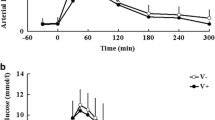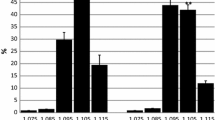Summary
The concentrations of lactate, ammonia and hypoxanthine were determined in blood from the femoral artery, femoral vein and cubital vein under resting conditions in 23 patients with stage II, 10 patients and 20 diabetics with stage IV peripheral arterial occlusive disease (PAOD) and in 19 healthy subjects. The metabolite concentrations were also measured immediately and 20 min after calf exercise in the patients with stage II PAOD and in the controls. At rest, there was a negative arteriovenous difference in femoral lactate level and a positive arteriovenous difference in the ammonia level in all groups. After exercise to the claudication limit, the femoral venous concentration and arteriovenous difference for lactate increased in the patient group significantly higher than in the controls, who were exercised three times as heavily. Furthermore, there was a significant rise in femoral venous ammonia concentration with inversion of the arteriovenous difference into the negative range and an increase in femoral venous hypoxanthine concentration only in the patients with PAOD and not in the controls. A significant correlation was found between the exercise-induced increases in lactate and ammonia. The results indicate activation of the purine nucleotide cycle in the muscles of limbs with impaired circulation, even for a short duration of load. This can be explained by activation of the AMP-deaminase in type I and type IIa muscle fibres by anoxaemia. The purine nucleotide cycle has an emergency metabolic function in ischaemia to maintain muscle contractility. Ammonia determination in femoral blood permits, in association with lactate and hypoxanthine determination, a precise quantitative assessment of the metabolic effects of PAOD.
Similar content being viewed by others
Abbreviations
- ADP:
-
adenosine diphosphate
- AMP:
-
adenosine monophosphate
- ATP:
-
adenosine triphosphate
- AVD:
-
arteriovenous difference
- IMP:
-
inosine monophosphate
- PAOD:
-
peripheral arterial occlusive disease
- PNC:
-
purine nucleotide cycle
References
Babij P, Matthews SM, Rennie MJ (1983) Changes in blood ammonia, lactate, and amino acids in relation to workload during bicycle ergometer exercise in man. Eur J Appl Physiol 50:405–411
Banister EW, Rajendra W, Mutch BJC (1985) Ammonia as an indicator of exercise stress. Implications of recent findings to sports medicine. Sports Med 2:34–46
Buono MJ, Clancy TR, Cook JR (1984) Blood lactate and ammonium ion accumulation during graded exercise in humans. J Appl Physiol 57:135–139
Da Fonseca-Wollheim F (1973) Direkte Plasmaammoniak-bestimmung ohne Enteiweißung. Z Klin Chem Biochem 11:427
Dudley GA, Staron RS, Murray TF, Hagerman FC, Luginbuhl A (1983) Muscle fiber composition and blood ammonia levels after intense exercise in humans. J Appl Physiol 54:582–586
Gardiner DG (1979) Analytical biochemistry 95:377–382
Heald DE (1975) Influence of ammonium ions on mechanical and electrophysiological responses of skeletal muscle. Am J Physiol 229:1174–1179
Hild R (1963) Stoffwechselumstellungen bei arterieller Verschlußkrankheit. Verh Dt Ges Kreislaufforsch 29:188–191
Hild R, Zolg H, Brecht T, Huber U (1964) Ergometrische Belastungen während intraarterieller Infusion eines Nucleotid-Nucleosid-Gemisches als neues Verfahren zur Behandlung der arteriellen Verschlußkrankheit. Med Welt I:614–624
Hild R, Brecht T, Zolg H (1966) Das Lactat/Pyruvat-System als Indicator des Ruhestoffwechsels bei arterieller Verschlußkrankheit der Gliedmaßen. Klin Wochenschr 44:44–47
Imai S, Riley AL, Berne RM (1964) Effect of ischemia on adenine nucleotides in cardiac and skeletal muscle. Circ Res 15:443–450
Lowenstein JM (1972) Ammonia production in muscle and other tissues: the purine nucleotide cycle. Physiol Rev 52:382–414
Mackie BG, Terjung RL (1983) Blood flow to the different skeletal muscle fiber types during contraction. Am J Physiol 245:H265-H275
Meyer RA, Terjung RL (1979) Differences in ammonia and adenylate metabolism in contracting fast and slow muscle. Am J Physiol 237:C111-C118
Meyer RA, Dudley GA, Terjung RL (1980) Ammonia and IMP in different skeletal muscle fibers after exercise in rats. J Appl Physiol 49:1037–1041
Noll F (1974) In: Bergmeyer HU (Hrsg) Methoden der enzymatischen Analyse. Verlag Chemie Weinheim, 3. Aufl. Bd II, S.1521
Patterson VH, Kaiser KK, Brooke MH (1982) Forearm exercise increases plasma hypoxanthine. J Neur Neurosurg Psych 45:552–553
Prince P, Hikida RS, Hagerman FC (1976) Human muscle fiber types in power lifters, distance runners, and untrained subjects. Pflügers Arch 363:19–26
Rexroth W, Hüpen M, Wagner E, Hild R (1987) Effekte von Iloprost auf Ruhedurchblutung und Extremitätenstoffwechsel bei Gesunden in Abhängigkeit von Dosierung und Applikationsart. VASA 16:72–76
Roos A, Boron WF (1981) Intracellular pH. Physiol Rev 61:296–434
Sinkeler SPT, Daanen HAM, Wevers RA, Oei TL, Joosten EMG, Binkhorst RA (1985) The relation between blood lactate and ammonia in ischemic handgrip exercise. Muscle & Nerve 8:523–527
Sørlie D, Myhre K, Saugstad OD, Giercksky KE (1982) Release of hypoxanthine and phosphate from exercising human legs with and without arterial insufficiency. Acta Med Scand 211:281–286
Sutton JR, Toews CJ, Ward GR (1980) Purine metabolism during strenuous muscular exercise in man. Metabolism 29:254–260
Weicker H (1988) Purinnukleotidzyklus und muskuläre Ammoniakproduktion. Dt Zschr Sportmed 39:172–178
Wheeler TJ, Lowenstein JM (1979) Adenylate deaminase from rat muscle: regulation by purine nucleotides and orthophosphate in the presence of 150 mM KCl. J Biol Chem 254:8994–8999
Wilkerson JE, Batterton DL, Horvath SM (1977) Exercise-induced changes in blood ammonia levels in humans. Eur J Appl Physiol 37:255–263
Author information
Authors and Affiliations
Additional information
Dedicated to Prof. Dr. R. Hild on the occasion of his 60th birthday
Rights and permissions
About this article
Cite this article
Rexroth, W., Hageloch, W., Isgro, F. et al. Influence of peripheral arterial occlusive disease on muscular metabolism. Klin Wochenschr 67, 576–582 (1989). https://doi.org/10.1007/BF01721684
Received:
Revised:
Accepted:
Issue Date:
DOI: https://doi.org/10.1007/BF01721684




